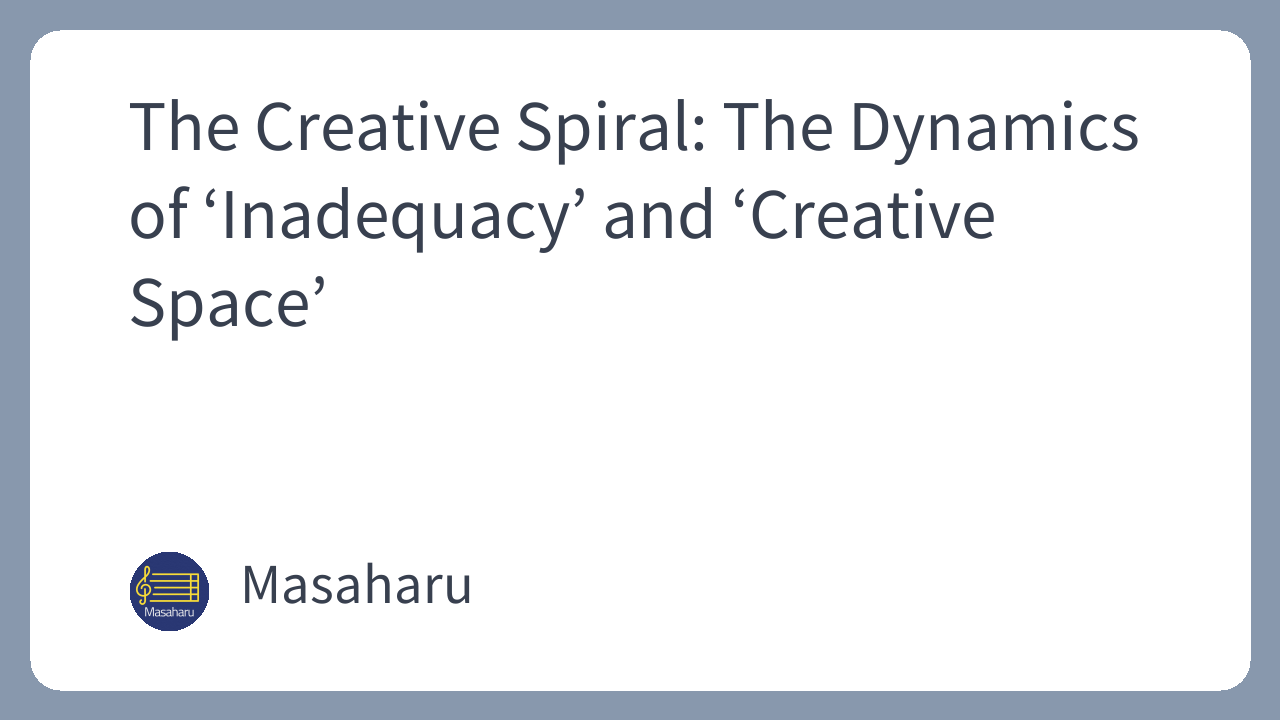It seems that many creators, myself included, are unconsciously trapped by a “curse of frantic effort.” Do we not perceive music production as a marathon, a relentless race toward a finish line without a moment’s rest or a single glance sideways? This mindset likely stems from the assumption that working with intense, desperate effort directly correlates with the quality of the final work.
However, it would be hasty to dismiss this “frantic effort” as entirely negative. I believe it is, in fact, an expression of a necessary phase of “inadequacy” within the creative cycle. This state interacts with the subsequent “creative space” (or margin) to form a dynamic process that elevates our work to a higher plane.
In this essay, I will frame this period of inadequacy, the root of our frantic efforts, as the “inhalation of creation,” and the resulting creative space as the “exhalation of creation.” From an introspective perspective, I will explore the dynamics of the “Creative Spiral” woven by these two intertwined states.
The Inhalation of ‘Inadequacy’: Immersion in Musical Truth
The creative cycle for an artist often begins with a feeling of “inadequacy.” This term does not simply refer to a lack of skill, but rather to the unbridgeable intellectual and emotional gap between what is (our current self) and what we envision as the ideal (the yet-unheard music). It is a persistent, unquenchable thirst.
When tackling a new musical idea or an unseen musical form, a composer almost invariably feels the insufficiency of their own abilities and a sense of impatience when their vision fails to materialize as sound. This internal state is the very core of the “frantic effort” we pour into music production. While this struggle brings mental strain, it also functions as the propulsive force pushing us to the next stage. Driven by the yearning for “yet-unheard music,” we explore the musical truth that lies beyond mere sequences of notes—a process invariably accompanied by this sense of desperation.
This period of “inadequacy” can be described as a musical “inhalation.” It involves greedily taking in various external elements and accumulating them internally. This means a thorough, inward focus: exploring the polysemy of a single chord in a harmony, seeking the most precise emotional expression in the phrasing, and breathing life into the subtle fluctuations of rhythm. Without passing through this phase of inadequate searching, it is difficult to arrive at new perceptions or unique musical expressions.
The Exhalation of ‘Creative Space’: Integration and an Objective Gaze
After a period of intense searching, stepping back from the work allows the creator to cultivate a space of “margin” or “creative space” within. This very space, I believe, becomes the force that organically connects disparate fragments and sublimates them into a unified musical form.
One way to create this space is a practice I once described as “taking a work-in-progress on an excursion.” This approach involves temporarily leaving the production environment to gain a different perspective, deepening introspection, and regaining an objective view of the work while simultaneously engaging with it more profoundly. Seemingly wasteful or roundabout activities—taking a walk, or immersing oneself in a completely different art form—actually nurture this internal margin, serving as an “exhalation” that breathes new life into the entire piece.
This time of “creative space” is not mere rest or escapism. It is an intellectual space where fragmented knowledge and experiences, which were not at the forefront of consciousness during production, can integrate beneath the surface. Only by stepping back from the fervor of creation to view the whole picture, or by pausing to re-engage in a dialogue with the work, can we notice the value of the “blank spaces” that were invisible in a state of frantic effort—such as the silence between notes or the room for expressive potential.
At the apex of this “creative space” lies what might be called a form of acceptance, rooted in the acknowledgment of human finitude and the understanding that we can never reach perfection or the ideal, yet we continue to strive. It is an attitude that quietly liberates us from the curse of seeking a flawless creation. The healthy stance of deciding, “This work is not perfect, but it is the best I can produce right now,” and releasing it to the world, is not an abandonment of creativity. Rather, this “acceptance” feels like a new starting point, allowing us to move on to the next creation without overly sanctifying the work.
Drawing the ‘Creative Spiral’
Ultimately, for a creator, creation may be a dynamic, spiral process of repeating two phases: the inhalation of “inadequacy” and the exhalation of “creative space.”
In a state of inadequacy, we greedily absorb new knowledge and techniques. In the subsequent period of creative space, we integrate and objectively evaluate them. By repeating this cycle, we not only improve our technical skills but also achieve inner intellectual and emotional growth, enabling us to produce works of greater depth.
This process, like a spiral ascending toward ever-greater heights, continues steadily, even if it is not always visible to the eye.
Related Articles



